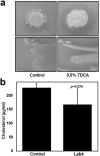The anti-cholesterolaemic effect of a consortium of probiotics: An acute study in C57BL/6J mice
- PMID: 28588193
- PMCID: PMC5460276
- DOI: 10.1038/s41598-017-02889-5
The anti-cholesterolaemic effect of a consortium of probiotics: An acute study in C57BL/6J mice
Abstract
Hypercholesterolaemia is a major risk factor for cardiovascular disease and it has been found that some probiotic bacteria possess cholesterol-lowering capabilities. In this study, the ability of the Lab4 probiotic consortium to hydrolyse bile salts, assimilate cholesterol and regulate cholesterol transport by polarised Caco-2 enterocytes was demonstrated. Furthermore, in wild-type C57BL/6J mice fed a high fat diet, 2-weeks supplementation with Lab4 probiotic consortium plus Lactobacillus plantarum CUL66 resulted in significant reductions in plasma total cholesterol levels and suppression of diet-induced weight gain. No changes in plasma levels of very low-density lipoprotein/low-density lipoprotein, high-density lipoprotein, triglycerides, cytokines or bile acids were observed. Increased amounts of total and unconjugated bile acids in the faeces of the probiotic-fed mice, together with modulation of hepatic small heterodimer partner and cholesterol-7α-hydroxylase mRNA expression, implicates bile salt hydrolase activity as a potential mechanism of action. In summary, this study demonstrates the cholesterol-lowering efficacy of short-term feeding of the Lab4 probiotic consortium plus L. plantarum CUL66 in wild-type mice and supports further assessment in human trials.
Conflict of interest statement
This study was supported by Cultech Ltd, Port Talbot, UK. DRM, TSD, DLC and SFP are or were employees of Cultech Ltd. JWEM is a PhD student funded by a joint studentship from the School of Biosciences, Cardiff University and Cultech Ltd.
Figures




References
-
- WHO. World Health Organisation, Fact Sheet 317 (2015).
-
- McLaren, J. E., Michael, D. R., Ashlin, T. G. & Ramji, D. P. Cytokines, macrophage lipid metabolism and foam cells: Implications for cardiovascular disease therapy. Prog Lipid Res50, 331-347, doi:1016/j.plipres.2011.04.002 (2011). - PubMed
MeSH terms
Substances
LinkOut - more resources
Full Text Sources
Other Literature Sources

